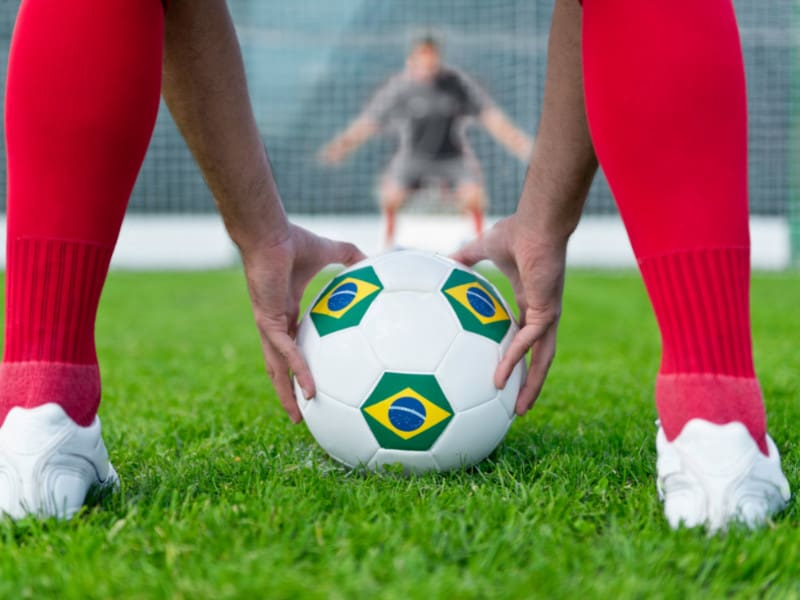

The attacking team surges into the opposition penalty box, and one of their players is brought to the ground.
The crowd roars, demanding a penalty. The referee blows their whistle and points to the spot. The crowd goes crazy!

Penalties are awarded when a player commits a foul in their own penalty box. The team awarded the penalty has a chance to take a shot on goal from 12 yards, striker vs. goalkeeper, with all other players having to stay outside the box until the ball is struck.
Penalty shoot-outs are often used in competitions to decide games that are tied.
At this point, a goal hasn’t even been scored, and the crowd is as excited as if one has. Ecstacy turns to nail-biting anticipation as the player places the ball on the penalty spot. It’s now 1 v 1, striker vs goalkeeper.
No matter the outcome, the striker is glorified for snatching an all-important goal, or the goalkeeper is praised as a hero for rescuing his team.
There is nothing quite like a penalty in a close soccer game.
For PK to be awarded by a referee, a player commits a foul in their own penalty box. Different fouls include handball, a trip, a push, pulling the opposition player’s jersey, a kick, a high-foot, and other serious fouls.
A backpass (where a goalkeeper handles a ball kicked or thrown to them intentionally by a teammate) is a foul in the penalty box, but it doesn’t result in a freekick.
Instead, an indirect free kick (a goal cannot be scored directly – it must touch another player or go out of play first) is awarded.

The ball must be in play for a penalty to be awarded and the following offenses can cause a penalty kick to be awarded, from the lawmakers at FIFA/IFAB;
See also How Many Players on A Soccer Team/Field/Substitutions (All Ages)


Penalty shootouts are viewed as tiebreakers, so none of the penalties scored in a shootout are registered as official goals, and they’re not added to the goal tally of the game.
For example, a game that ends in a shootout may be recorded as:
Although a huge element of skill is involved in winning a penalty shootout, due to the “one-chance, one-shot” nature of each penalty, there is quite a bit of luck involved.
The weather, field conditions, a slip, or a lucky guess from the goalkeeper, amongst other factors, can impact the outcome of a PK.
That being said, few moments can match the thrill and drama of a shootout. It’s a thrilling way to end a game.

Penalty shootouts have determined many finals. Some of the most notable international competitions decided by PKs are:
In 1882, a law was introduced whereby a team was awarded a goal if they were prevented from scoring by a handball. This was to punish egregious defensive tactics that were previously gotten away with.
Although this rule only lasted a single season, it was the catalyst for implementing the original penalty rule.
The invention of the PK is largely credited to the former goalkeeper, William McCrum, from Armagh, Ireland. In 1890, he, along with the Irish Football Association, brought forward the idea to the IFAB (International Football Association Board) at a meeting.
However, they deferred deliberation on the rule for next year’s meeting.
Two major incidents of handball occurred the following season in the quarter-final stages of the English and Scottish cups. In either game, blatant handballs prevented goals from being scored.
These incidents further helped the Irish FA with their argument about why penalties needed to be introduced for such infractions.
On June 2nd, 1891, the kick law in the history of soccer was introduced as the first penalty. However, it was far from the rule of today. In summary:
Two significant adaptations were added to the rule shortly after its introduction, most notably:
Over the following century, gradual changes were continually made, bringing PKs to where they’re today.
PKs didn’t always exist, however. They were first introduced in 1890. Since then, we’ve seen many changes in what warrants a penalty and repercussions.
The rules surrounding the taking and saving penalties and different techniques and methods of shooting them. Let’s take a look at all you need to know.
PKs are crucial to the game of soccer. Over the years, the rules and governing of the game have developed to the point where they’re unlikely to change significantly in the future.
In the last couple of years, the introduction of VAR (video assistant referee) has scrutinized referees and their decisions.
There have been several high-profile penalty incidents that have caused controversy in the VAR era. However, the issues do not lie with the penalties themselves.
With the reasons behind awarding them and the teething problems that the sport is enduring with the introduction of technology.
Penalties, by their very nature, are dramatic and controversial. That’s unlikely ever to change. Although luck plays a big part, penalty shootouts provide some of the most thrilling moments in every competition.
The cruelty of a crushing shootout defeat can only be overcome by the relief and joy experienced by winning one.
Here’s to many more moments of hysteria, nervous excitement, agony, thrills, and everything that comes with penalties and penalty shootouts.